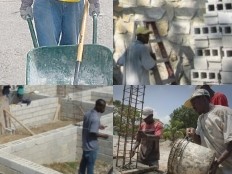|
||||||||||||||||||
|
|
Haiti - Reconstruction : (VI) Job creation - Strategic Plan 09/01/2011 07:15:48
While donors begin to fulfill their pledges and have difficulty accessing the facts about what is needed most on the ground, many are asking how to prioritize their spending. The strategic plan presented at the fourth meeting of the IHRC, December 14, 2010 at Santo Domingo in the Dominican Republic, will help guide the project implementers, donors and investors as they guide the disbursement of their pledges for the reconstruction and development of Haiti, and add much needed new funding. Developed jointly by the Commission, international experts and ministry leaders, this plan outlines many of the most important things needed in Haiti by October 2011, the end of IHRC’s mandate. Each day of the week we'll discover a part of this strategic plan for 2011. Today we cover the job creation. Targets and rationale Job creation is a top priority for Haiti’s recovery. While employment statistics are difficult to measure, Haiti has the highest unemployment rate in the region and likely the whole developing world. At least 70% of the population does not have stable jobs and the percentage of the population below 18 only increases the urgency of creating means for stable income earning. Job creation is necessarily a cross-sectoral effort and is often a result of indirect stimuli – many new jobs will come through a strong recovery and increased investment. Targets are therefore directional and more heavily dependant on the progress of the overall recovery effort. Nevertheless, in the spirit holding itself and the international community accountable, the IHRC puts forward the following aspirations:
Programs required and interdependencies with other sectors There are several ways in which the IHRC can stimulate job growth:
The IHRC is doing all three of these things. The IHRC is mainstreaming job creation through its project review process, mandating that projects maximize local job creation. It has also approved several projects, such as a $174 M industrial park, that will create tens of thousands of new sustainable jobs. Furthermore, the Commission has always made it known that Haiti is open for investment, and is working to convert the remarkable response from the international community into sustainable investment in Haiti’s private sector. Donors can help achieve its job creation target in three ways. First, they can be mindful of the Commission’s criteria as they relate to job creation. In particular, with regard to using local labor and services, sourcing locally, and designing programs to build the capability of workers. Below is the specific criteria used by the commission to evaluate projects that are applicable to job creation. Criterion 8: Sustainable Change / Does the project promote sustainable change? Project sustainability Does the project have an adequate plan in place to ensure that GOH or other entities or project beneficiaries will have sufficient resources and/or capabilities to sustain the project's impact? General considerations - Does the project provide for sufficient capability building and training so that local Haitians can gain long-term benefit from the project and/or take a greater role in its continuing operation? - Does the project provide for sufficient support for ongoing operations of the infrastructure or facilities created by the project? - Does the project have a clear plan for transferring responsibilities for operating costs to the Government or other entities? Or, does the project have a plan for establishing cost-recovery measures to ensure the project is continuously viable? - Similarly, does the project have a method for gaining buyin to the long-term success of the project from the local community? - Where relevant, do the projects build back better to reduce risk from disasters, including earthquakes, fires, hurricanes and other natural shocks? Criterion 9: Local sourcing / Where relevant, does the project intend to maximize its use local resources given its scope and objectives? Local jobs Does the project appear to have taken prudent steps to create local jobs? General considerations - Does the project use the level of local labor that might be expected given the project objectives, the skills required to complete the project and the skill of local labor? - Does the project take steps to increase the amount of local labor that it uses over time through training programs and other capability building measures? Local sourcing Does the project appear to have taken prudent steps to source material locally? General considerations - Does the project use the local materials that it might be expected to use given the objectives of the project, the materials required and the availability/practicality of obtaining the materials in Haiti? - Does the project take steps to increase its local sourcing over time? - Does the project adequately consider whether its procurement policies and the services it provides negatively impact the local economy by replacing what the local economy could have supported/provided on its own? Examples of projects taking the above considerations seriously abound. The World Bank submitted a housing project that will utilize and train local workers to help with the repair and construction of Housing. A project by the Solar Electric Light Fund, an NGO, will employ 195 Haitians to install solar powered energy and will train 3 Haitians to maintain the equipment permanently. Second, donors can help achieve job creation targets by designing and submitting projects to directly produce sustainable jobs – the IHRC has specified that it would like 2 public and 3 private industrial parks to be under construction by October 11. The government of Haiti, USAID and the IDB worked together on the first phase of creating an industrial park, which will eventually employ 65,000 people directly. Other projects that produce sustainable jobs are, of course, welcome and will be considered by the Commission. For example, The IDB created a financing facility for small and medium enterprises, which will stimulate local job creation. Third, by engaging with the Commission, and spreading the message about what the international community is investing in Haiti, donors can help to attract private investment. Donors can also structure programs to incentivize private investment in the country. See also: https://www.haitilibre.com/en/news-2033-haiti-reconstruction-i-housing-strategic-plan.html https://www.haitilibre.com/en/news-2040-haiti-reconstruction-ii-debris-removal-and-management-strategic-plan.html https://www.haitilibre.com/en/news-2047-haiti-reconstruction-iii-education-strategic-plan.html https://www.haitilibre.com/en/news-2054-haiti-reconstruction-iv-health-strategic-plan.html https://www.haitilibre.com/en/news-2062-haiti-reconstruction-v-energy-strategic-plan.html https://www.haitilibre.com/en/news-2073-haiti-reconstruction-vii-water-and-sanitation-strategic-plan.html https://www.haitilibre.com/en/news-2082-haiti-reconstruction-viii-reinforcement-of-institutions-strategic-plan.html HL/ S/ HaitiLibre/ CIRH
|
|
|
Why HaitiLibre ? |
Contact us |
Français
Copyright © 2010 - 2024 Haitilibre.com |



